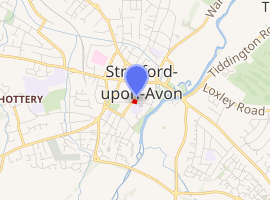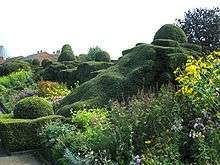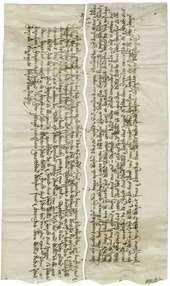New Place
New Place (grid reference SP201548) was William Shakespeare's final place of residence in Stratford-upon-Avon. He died there in 1616. Though the house no longer exists, the site is owned by the Shakespeare Birthplace Trust, which maintains it as a specially-designed garden for tourists.
| New Place | |
|---|---|
New Place sketched by George Vertue from contemporary descriptions when he visited Stratford-on-Avon in 1737 | |

| |
| General information | |
| Address | Chapel Street, Stratford-upon-Avon, Warwickshire, England |
| Completed | 1483 |
| Demolished | 1759 |
| Client | Sir Hugh Clopton |
| Owner | Shakespeare Birthplace Trust (site) |
| Website | |
| https://www.shakespeare.org.uk/visit/shakespeares-new-place/ | |

Early history
The house stood on the corner of Chapel Street and Chapel Lane, and was apparently the second largest dwelling in the town. It was built in 1483 by Sir Hugh Clopton, a wealthy London mercer and Lord Mayor. Built of timber and brick (then an innovation in Stratford) it had ten fireplaces, five handsome gables, and grounds large enough to incorporate two barns and an orchard.[1]
In 1496 Sir Hugh Clopton left New Place in his will to his great-nephew William Clopton I ('my cousin William Clopton') and the male heirs of the lordship of Clopton.[2] In his will William Clopton I (d. 29 May 1521) granted his wife, Rose (d. 17 August 1525)[3] a life interest in the property, with the reversion after her death to his son, William Clopton II. In November 1543 the latter leased it for forty years to a surgeon, Thomas Bentley (d.1549), who left his wife, Anne, a life interest in the lease during her widowhood. Anne remarried, however, and after she became the wife of Richard Charnock, William Clopton II retook possession of New Place. By his wife Elizabeth Grey, the daughter of Sir Edward Grey of Enville, Staffordshire, William Clopton II had a son, William Clopton III (1537–1592), to whom he left New Place by will in 1560. On 20 December 1563, hard-pressed for money to pay his sisters' marriage portions and continue travelling in Italy, William Clopton III sold New Place to William Bott, who had already resided in it for several years. In 1567 Bott sold New Place to William Underhill I (c. 1523 – 31 March 1570), an Inner Temple lawyer and clerk of assizes at Warwick, and a substantial property holder in Warwickshire.[4][5][6][7][8]
Sale to Shakespeare

At his death in 1570, Underhill left New Place to his son, William Underhill II (d.1597), who in 1597 sold it to William Shakespeare for £60. He (William Underhill II) died two months later, and it emerged that he had been poisoned by his eldest son and heir, Fulke Underhill. According to some sources, Fulke Underhill died in May 1598 while still a minor and before the fact that he had murdered his father was discovered.[9][10][11] According to other sources, however, Fulke Underhill was hanged in 1599 for his father's murder and attainted for felony, whereby his property, including New Place, was forfeit to the crown.[12][7] In 1602 the Court of Exchequer appointed a commission to "obtain an account of the possessions of Fulke Underhill of Fillongley, county Warwick, felon, who had taken the life of his father, William Underhill, by poison".[9] When Fulke's younger brother, Hercules Underhill, came of age in 1602, his father's former properties were regranted to him, and he and Shakespeare negotiated a confirmation of the sale.[12][7][13]
After Shakespeare's death
In 1616 the house passed to his daughter Susanna Hall, and then his granddaughter, Elizabeth Hall, who had recently remarried after the death of her first husband, Thomas Nash, who had owned the house next door. After Elizabeth died, the house was returned to the Clopton family.
In 1702 John Clopton radically altered, or rebuilt, the original New Place – contemporary illustrations suggest the latter. In 1756 then-owner Reverend Francis Gastrell, having become tired of visitors, attacked and destroyed a mulberry tree in the garden said to have been planted by Shakespeare.[14] In retaliation, the townsfolk destroyed New Place's windows. Gastrell applied for local permission to extend the garden. His application was rejected and his tax was increased, so Gastrell retaliated by demolishing the house in 1759. This greatly outraged the inhabitants and Gastrell was eventually forced to leave town.[14]
The Shakespeare Birthplace Trust acquired New Place and Nash's House in 1876. Today the site of New Place is accessible through a museum that resides in Nash's House, the house next door.[15] The site received 109,452 visitors during 2018.[16]
Archaeological excavations
Excavations in the grounds of Nash's House were carried out during 2010, 2011 and 2012 by Birmingham Archaeology.[17] Archaeologists from Time Team visited the dig during 2011 and a special programme on the subject, "Searching for Shakespeare's House", was transmitted on 11 March 2012.[18] BBC One National Treasures broadcast a live programme from the site in August 2011.[19] Findings from the excavation indicated the presence of a Tudor structure but were inconclusive as to the ground plan of Shakespeare's original house.
Clay pipe fragments at Stratford-upon-Avon
Clay pipe fragments unearthed in recent years in Shakespeare's Stratford-upon-Avon garden were found to possibly contain traces of cannabis, along with tobacco and camphor, based on the results of a study published in the South African Journal of Science.[20][21] This has fuelled speculation by some that Shakespeare may have possibly smoked cannabis,[22] which is known to have been used to treat certain medical conditions at the time by Elizabethans, as well as in the manufacture of materials such as sails, rope, and clothing, and may have also been used for purposes of pleasure.[20] The pipe fragments, however, could have belonged to any number of other persons besides the famous playwright, and cannot be definitively dated to the periods of his residency there.[20]
Gallery
 Gardens
Gardens Knot Garden, New place.
Knot Garden, New place. Artist impression of Shakespeares New Place opening July 2016
Artist impression of Shakespeares New Place opening July 2016
See also
Notes
- Bryson, Bill (2008). Shakespeare: The World as a Stage. London: Harper Perennial. p. 119. ISBN 978-0-00-719790-3.
- Lawrence 1890, p. 154.
- Rose later married Sir Giles Greville; Fetherston 1877, p. 109.
- Lawrence 1890, pp. 154–5.
- Fetherston 1877, pp. 109–110.
- Stopes 1907, pp. 228–30.
- Schoenbaum 1989, p. 17.
- Palmer & Palmer 1981, p. 49.
- Stopes 1907, p. 232.
- Stopes 1916, pp. 260–1.
- Phillips 2005, pp. 6–7.
- Schoenbaum 1977, p. 234.
- 'Final Concord Between William Shakespeare and Hercules Underhill', World Digital Library Retrieved 20 December 2013.
- Winterman, Denise (7 March 2013). "The man who demolished Shakespeare's house" – via www.bbc.co.uk.
- British Archaeology The Voice of Archaeology in Britain and Beyond. Issue 113 July/August 2010
- "ALVA - Association of Leading Visitor Attractions". www.alva.org.uk. Retrieved 28 August 2019.
- ""Digging deeper for Shakespeare", Shakespeare Birthplace Trust website". Archived from the original on 5 November 2011.
- "Unofficial Time Team website". Archived from the original on 20 February 2012. Retrieved 12 March 2012.
- "BBC One National Treasures Live on location at the Dig for Shakespeare tonight". Shakespeare Birthplace Trust website. Archived from the original on 6 January 2014.
- Smillie, Shaun (1 March 2001). "Did Shakespeare Puff on 'Noted Weed'?". National Geographic News. Retrieved 8 August 2015.
- Thackeray, F (2015). "Shakespeare, plants, and chemical analysis of early 17th century clay 'tobacco' pipes from Europe" (PDF). South African Journal of Science. 111 (7/8): a0115. doi:10.17159/sajs.2015/a0115. Archived from the original (PDF) on 14 August 2015. Retrieved 17 August 2015.
- Mabillard, Amanda (20 August 2000). Did Marijuana Fuel Shakespeare's Genius?. www.shakespeare-online.com. Retrieved 8 August 2015.
References
- Fetherston, John, ed. (1877). The Visitation of the County of Warwick in the year 1619. XII. London: Harleian Society. Retrieved 21 December 2013.CS1 maint: ref=harv (link)
- Lawrence, L. L. (1890). "New Place and Gastrell". Shakespeariana. New York: Leonard Scott Publication Co. VII: 151–60. Retrieved 21 December 2013.CS1 maint: ref=harv (link)
- Palmer, Alan Warwick; Palmer, Veronica (1981). Who's Who in Shakespeare's England. New York: St. Martin's Press. p. 49. Retrieved 21 December 2013.CS1 maint: ref=harv (link)
- Phillips, Owen Hood (2005). Shakespeare and the Lawyers (reprint of 1572 ed.). New York: Routledge. pp. 6–7. Retrieved 29 December 2013.CS1 maint: ref=harv (link)
- Schoenbaum, Samuel (1989). Dotterer, Ronald (ed.). "Shakespeare: Text, Subtext and Context: All That is Known Concerning Shakespeare". Susquehanna University Studies. Selingrove, PA: Susquehanna University Press. 13: 15–30. Retrieved 21 December 2013.CS1 maint: ref=harv (link)
- Schoenbaum, Samuel (1977). William Shakespeare: A Compact Documentary Life. New York: Oxford University Press. p. 234. Retrieved 21 December 2013.CS1 maint: ref=harv (link)
- Stopes, Charlotte Carmichael (1916). Shakespeare's Industry. London: G. Bell and Sons. pp. 260–1. Retrieved 29 December 2013.CS1 maint: ref=harv (link)
- Stopes, Charlotte Carmichael (1907). Shakespeare's Warwickshire Contemporaries. Stratford upon Avon: Shakespeare Head Press. pp. 227–32. Retrieved 21 December 2013.CS1 maint: ref=harv (link)
Further reading
- Bearman, Robert, 'Shakespeare's Purchase of New Place', Shakespeare Quarterly, Volume 63, Number 4, Winter 2012, pp. 465–86.
- Watts, Percy R., 'Shakespeare's "Double" Purchase of New Place' (1947), 20 Australian Law Journal, pp. 330–36.
External links
![]()
- Official website
- Deed to lead uses from William Clopton to William Bott of Stratford and Thomas Goodale, 20 December 1563 Folger Shakespeare Library Retrieved 21 December 2013
- Bargain and sale from William Clopton to William Bott, 20 February 1563, Folger Shakespeare Library Retrieved 21 December 2013
- Underhill, Fulke: Warwick, Inquisition post mortem, C 142/258/29, 1598–9, National Archives Retrieved 29 December 2013
- Fillongley Inquisition (commission only) as to the possessions of Fulke Underhill, attainted, E 178/2362, 1601–2, National Archives Retrieved 29 December 2013
- Inquisition as to lands and goods of Fulke Underhill, attainted, E 178/7358, 1601–2, National Archives Retrieved 29 December 2013
- Shakespeare's last house: Archaeologists reveal more, BBC News, 22 December 2013 Retrieved 23 December 2013
.png)